9 Creative Ways to Make Storytime Exciting for Kids
Ever had to compete with an iPad for your child’s attention during storytime? Yeah, not fun. I’ve watched my own 5-year-old’s eyes glaze over while I’m reading the same book for the fifteenth time, using the same old boring voice.
But here’s the deal: creative storytime activities aren’t just about keeping kids entertained—they’re about building lifelong readers and thinkers.
I’ve spent years testing different ways to make storytime exciting for kids, and I’m about to share nine approaches that actually work. These aren’t your typical “just do funny voices” suggestions (though that’s in here too).
What makes these different? They’re the techniques that got my son to actually put down the tablet and say, “Read it again, but do the monster part!”
AI: Just wait till you see #6.
Transform Your Reading Voice
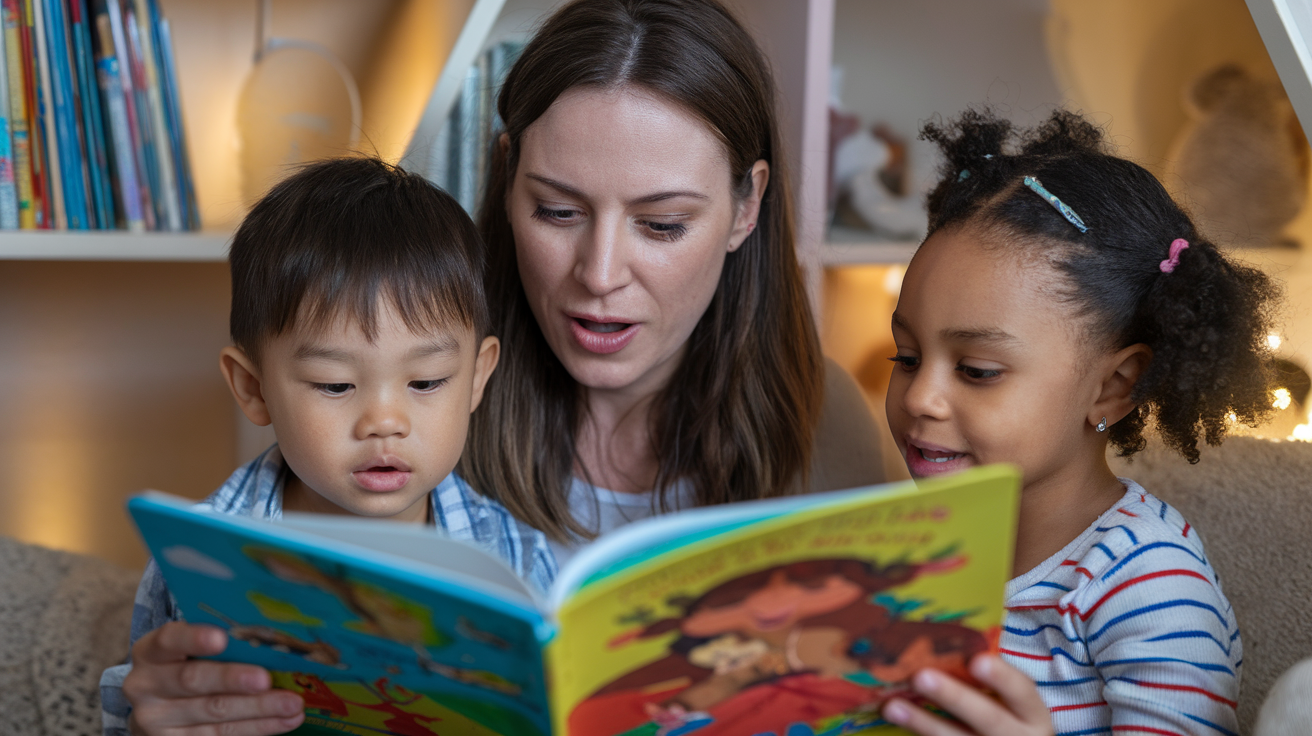
Master Different Character Voices
Reading in a flat monotone voice? That’s a surefire way to lose your kid’s attention faster than you can say “once upon a time.”
The magic happens when you bring characters to life with distinct voices. Think about it – wouldn’t your little one be more captivated by a growly bear, a squeaky mouse, or a booming giant?
Start simple. For younger characters, raise your pitch slightly. For villains, go deeper and perhaps a bit slower. For magical creatures, try something whimsical and sing-songy.
Not sure where to begin? Try these quick character voice tricks:
- The Wise Owl: Speak slowly with a slight British accent
- The Excited Puppy: Fast-paced with occasional “barks” of enthusiasm
- The Grumpy Troll: Gravelly and low, with a bit of a grumble
Don’t worry about sounding perfect. Kids aren’t voice critics – they’re just thrilled you’re making the effort!
Use Sound Effects to Bring Stories Alive
Why just tell the story when you can create an entire soundscape? Adding sound effects takes storytime from basic to blockbuster instantly.
When the story mentions rain, tap your fingers lightly on the book. For footsteps, pat your thighs. A door closing? Clap once. The wind howling? Blow softly near your child’s ear.
Encourage your little one to join in! Hand them a pot and spoon for thunder or ask them to help with animal sounds. Before you know it, storytime becomes an interactive performance you’re creating together.
Some parents feel silly making these noises at first. Push through that feeling! The wide-eyed wonder on your child’s face will be worth every awkward moment.
Change Your Tempo and Volume for Dramatic Effect
The secret weapon in your storytelling arsenal? Pacing and volume.
Speed up during exciting chase scenes, making your words tumble out breathlessly. Then… slow… way… down… when revealing something important. This creates natural suspense that keeps kids hanging on every word.
Volume works the same way. A sudden whisper makes children lean in closer. They know something big is coming! Then, when the monster finally appears – BOOM! – a loud exclamation makes them jump with delighted surprise.
Try this pattern in your next reading session:
- Start at normal volume
- Gradually get quieter as tension builds
- Pause dramatically before the climax
- Burst into animation at the exciting part
Your voice is an instrument – play with it! The more you vary your delivery, the more engaged your audience will be.
Create Immersive Reading Environments
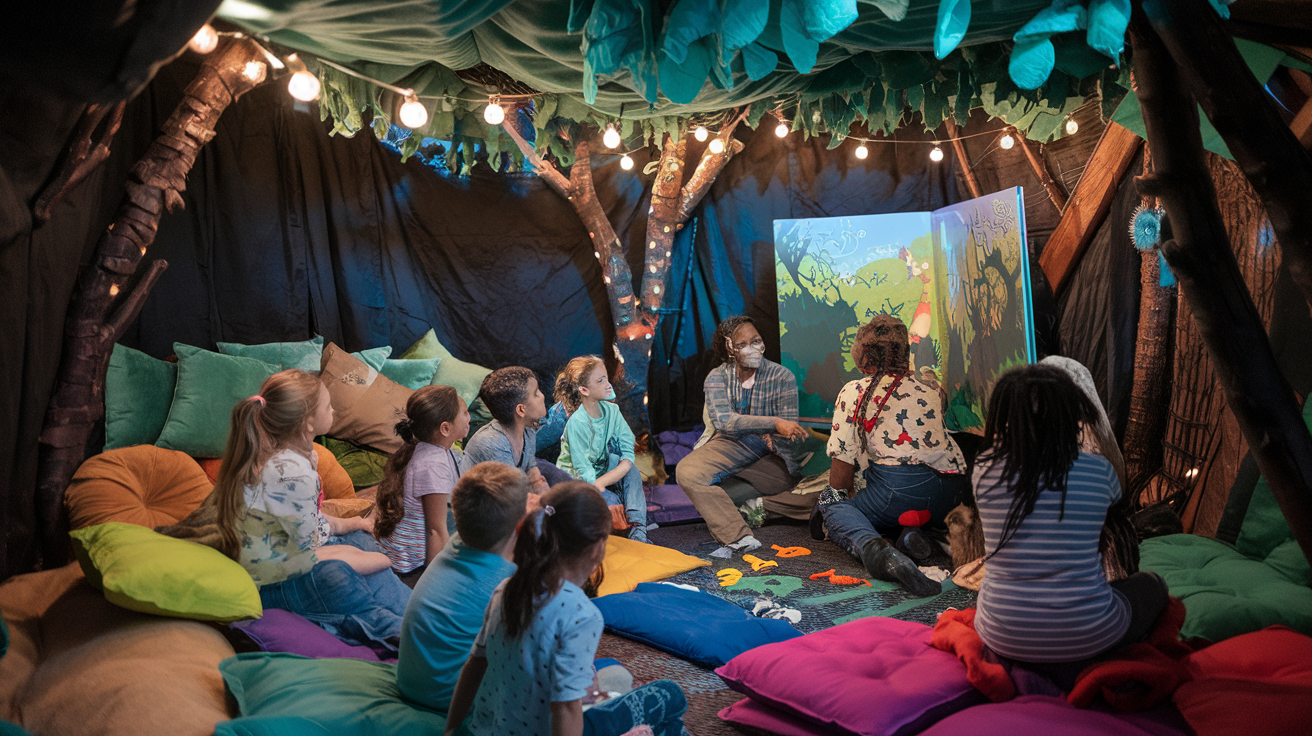
Build Simple Reading Forts with Blankets and Pillows
Remember when you were a kid and building a fort was the highlight of your day? That magic doesn’t disappear when it comes to reading. Grab some sheets, blankets, and every pillow in the house to create a cozy reading sanctuary that’ll make your little one excited about storytime.
The best part? You don’t need fancy equipment. Just drape a sheet over some chairs or between the couch and coffee table. Add some pillows, stuffed animals, and maybe a string of fairy lights. Boom—instant reading paradise.
My nephew Tyler used to hate reading until we started our “Thursday Fort Nights.” Now he reminds me every Wednesday to bring new books for our fort adventures.
Use Special Lighting to Set the Mood
The right lighting can transform an ordinary reading session into something extraordinary. Ditch the harsh overhead lights and try these instead:
- Fairy string lights hung around your reading area
- A small lamp with a colored bulb
- Glow sticks for spooky stories
- Flashlights for under-the-blanket reading adventures
- Battery-operated candles (real ones are a no-go with kids!)
Switch up the lighting based on the story. Reading about space? Use blue lights and glow-in-the-dark stars. Jungle adventure? Green lights with leaf shadows.
Create Themed Reading Spaces Based on the Story
Taking the immersive experience up a notch means matching your environment to your book. Reading “Where the Wild Things Are”? Transform your living room into a jungle with some houseplants, stuffed animals, and green blankets.
Here are some quick theme ideas:
- Ocean adventures: Blue sheets, seashells, and ocean sounds
- Magical kingdoms: Pillowcase capes, paper crowns, and a “throne” made of cushions
- Space exploration: Aluminum foil decorations, star projectors, and astronaut snacks
- Dinosaur tales: Hidden toy dinosaurs, brown/green color scheme, and prehistoric sound effects
Kids absolutely love this level of commitment. My friend’s daughter went from reluctant reader to bookworm after they started creating “book worlds” in their living room.
Incorporate Background Music That Matches the Tale
The soundtrack to your story can make all the difference. Think about movies—they use music to create tension, excitement, or calm. You can do the same with storytime!
Try these music pairings:
- Classical music for fairy tales (Tchaikovsky works wonders)
- Nature sounds for outdoor adventure stories
- Gentle piano for bedtime stories
- Movie soundtracks that match your story’s theme
- Soft jazz for detective stories
You don’t need anything fancy—just use your phone or computer to play background tracks quietly. The key is keeping the volume low enough that your voice remains the star of the show.
Some parents worry music might distract kids, but it actually helps many children focus by blocking out other household noises.
Engage Multiple Senses During Storytime
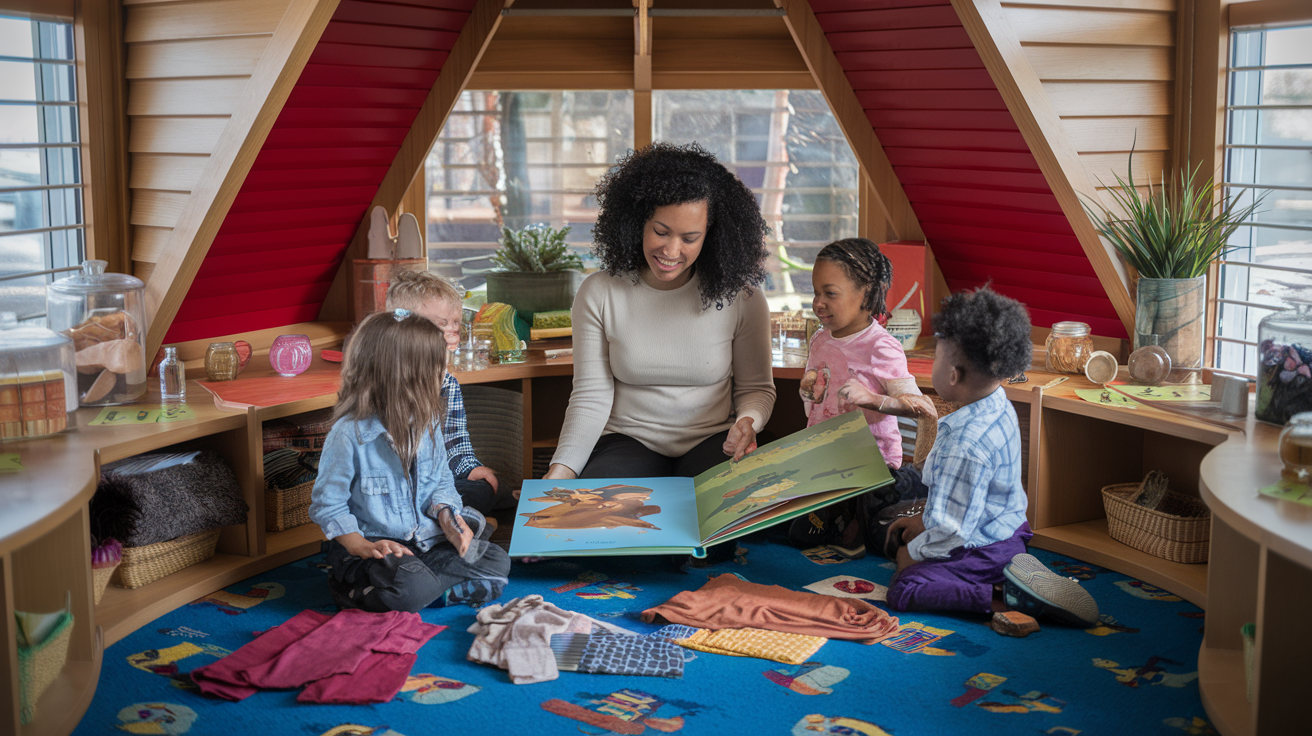
Engage Multiple Senses During Storytime
Kids experience the world through all their senses, not just their ears and eyes. When you bring multiple senses into storytime, something magical happens – stories transform from words on a page into immersive adventures that kids can’t wait to dive into.
A. Introduce Scents Related to the Story
Smell is powerfully connected to memory and emotion. Think about it – have you ever caught a whiff of something that instantly transported you back to childhood?
Try these scent-sational ideas:
- Use essential oil diffusers when reading about forests (pine or cedar oils)
- Bring fresh flowers for garden stories
- Have cinnamon sticks or vanilla extract nearby for baking tales
- Keep coffee beans in a jar for stories about cafés or morning routines
My nephew Jake was completely disinterested in our nightly reading until I brought out orange peels while reading about a citrus grove. His eyes lit up, and suddenly he was fully engaged!
B. Provide Themed Snacks That Connect to the Plot
Kids love snacks. Period. But themed snacks? That’s next-level excitement.
Match simple treats to your story:
- Blueberries for “Blueberries for Sal”
- Star-shaped cookies for space adventures
- Tiny sandwiches cut into character shapes
- Green foods for “The Very Hungry Caterpillar”
The beauty of story snacks is they create anticipation. My friend’s daughter now asks, “What are we eating with our story tonight?” before anything else.
C. Create Touchable Props for Sensory Exploration
Nothing beats hands-on learning for young minds. Props transform passive listening into active exploration.
Winning prop ideas:
- Fabric swatches with different textures for touching
- Water beads in a sealed bag for ocean stories
- Stuffed animals matching story characters
- Feathers, rocks, or leaves from nature stories
The first time I brought out a fuzzy blanket during a winter tale, my normally fidgety niece sat still for the entire book, stroking the blanket and fully absorbed in the story.
Make Stories Interactive
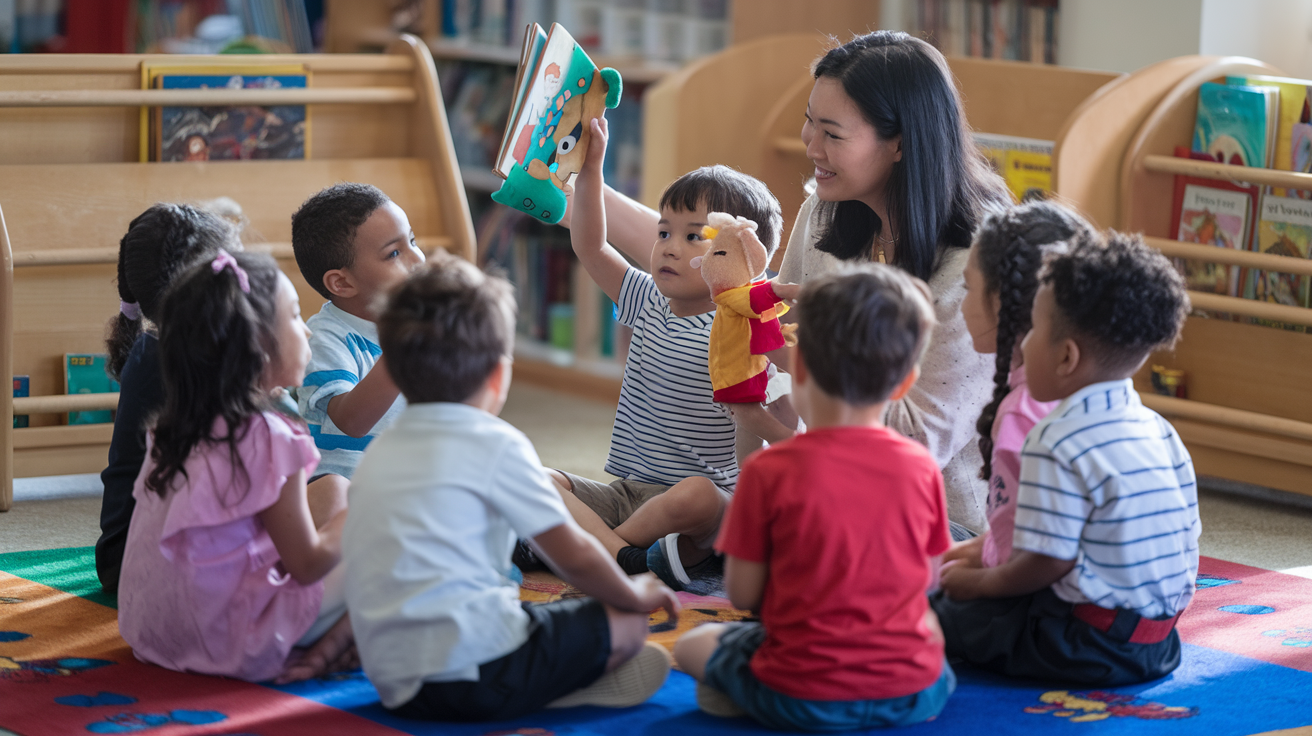
Pause for Predictions About What Happens Next
Kids love feeling involved in stories. Try stopping at key moments and asking, “What do you think happens next?” Their eyes light up as they become part of the storytelling process. This simple technique transforms passive listening into an adventure they help create.
Next time you read, watch for cliffhanger moments – just before the character makes a big decision or when danger approaches. These are perfect spots to pause and let their imaginations run wild. Their predictions might surprise you!
Ask Open-Ended Questions Throughout the Story
Forget yes-or-no questions. They’re conversation killers. Instead, try “Why do you think the character did that?” or “How would you feel if you were in their shoes?”
These questions spark deeper thinking and keep kids mentally engaged. They’ll start connecting the story to their own lives and experiences. Plus, there’s no right or wrong answer – which makes even shy kids more willing to speak up.
Assign Characters for Kids to Act Out
Turn reading time into an impromptu play! Assign different characters to each child and let them act out the dialogue as you narrate. They’ll love adding their own spin with funny voices and dramatic gestures.
For younger kids, simple role-playing works great. Older children might enjoy creating props or planning small performances based on scenes from the book. This approach works especially well for stories with lots of characters and dialogue.
Create Fill-in-the-Blank Moments for Children’s Input
Want to take interaction to the next level? Try leaving gaps in the story for kids to fill. “And then the princess found a magical… what do you think she found?”
This technique works magic with familiar stories. After reading a book several times, start omitting words or sentences and let them complete them. You’re not just reading anymore – you’re co-creating!
Use Puppets to Engage Younger Readers
Puppets transform storytime completely. Even the shyest toddlers perk up when a puppet “reads” to them. You don’t need anything fancy – sock puppets, paper bag characters, or even stuffed animals work perfectly.
Try having the puppet ask questions or make silly mistakes that kids can correct. Sometimes children who won’t talk to adults will happily chat with puppets. It creates a magical buffer that makes participation feel safer and more fun.
Incorporate Technology Thoughtfully
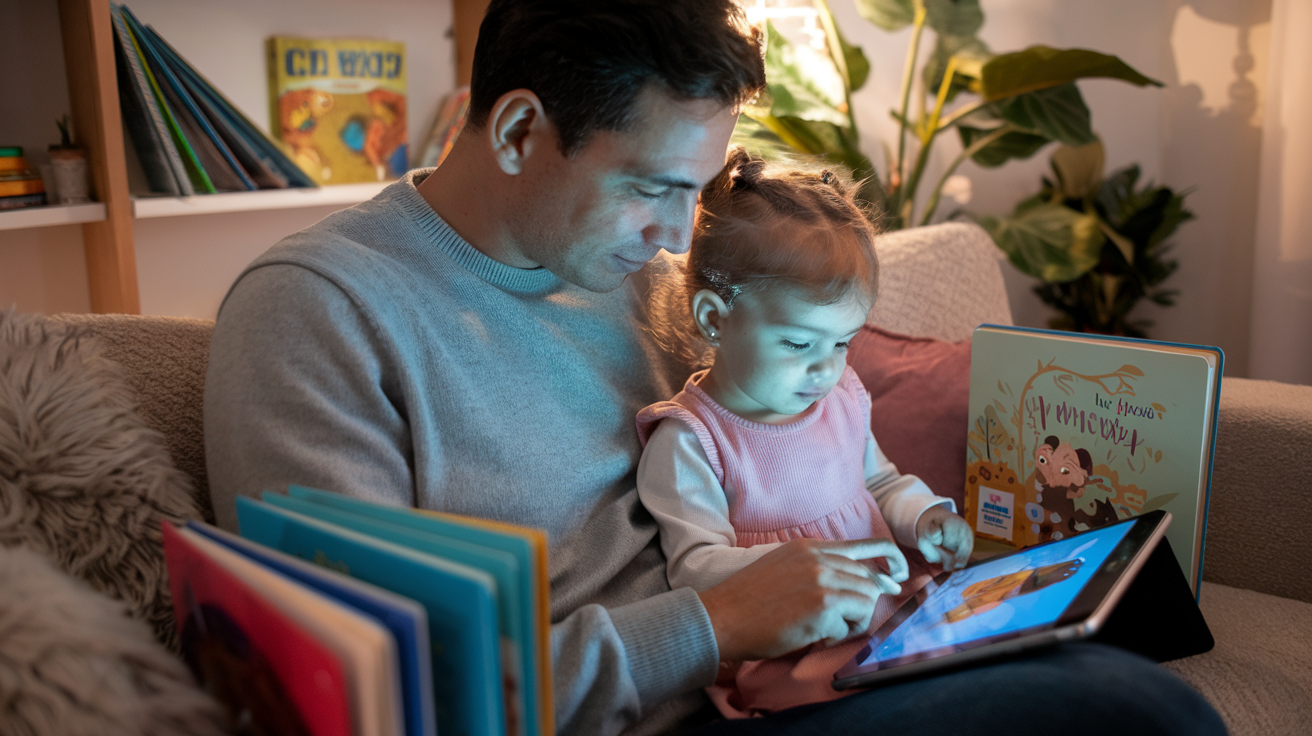
Find Augmented Reality Books That Come to Life
Remember those magical paintings in Harry Potter that moved? Well, now your kids can experience that same wonder with augmented reality (AR) books. These incredible books use your smartphone or tablet to transform ordinary pages into animated adventures right before your child’s eyes.
My nephew was completely mesmerized the first time he saw dinosaurs stomping across the pages of his favorite book. His jaw literally dropped! It wasn’t just passive entertainment either—he was interacting, learning, and completely absorbed in the story.
Some fantastic AR books to try:
- “My Very Hungry Caterpillar AR” – Watch Eric Carle’s beloved character crawl across your coffee table
- “Disney Princess: Enchanted Storybooks” – See Cinderella’s carriage materialize in your living room
- “Earth Book” – Explore 3D landscapes and animals from different ecosystems
Record Your Child Narrating Their Favorite Parts
Kids love hearing their own voices (shocking, I know). Recording them reading or retelling stories creates an instant keepsake and boosts their confidence as storytellers.
Try this tonight: After reading a book, ask your child to retell their favorite scene. Record it on your phone, then play it back. Watch their face light up! This simple activity reinforces comprehension skills and gives them ownership of the story.
Use Story-Related Apps as Companions to Physical Books
Digital tools work best when they enhance—not replace—traditional books. Many publishers now offer companion apps that expand the storytelling experience.
The “Goodnight Moon” app, for example, includes interactive elements that complement the physical book perfectly. Your child can touch the screen to make the cow jump over the moon or help find the mouse on each page.
What makes these apps special is that they maintain the core reading experience while adding elements that spark curiosity. Think of them as the special features on a DVD—extras that make the main attraction even better.
Turn Reading into a Game

Create Reading Bingo Cards with Story Elements
Kids love games, and bingo is a hit with almost any age group! Create custom bingo cards featuring elements from the books you’re reading together. Each square might contain:
- A character’s name
- A specific setting in the story
- Common words that appear in the book
- Key events
- Objects mentioned in the story
As you read, kids mark off squares when they hear these elements. The first to get five in a row wins! This not only makes reading interactive but encourages active listening. Plus, creating the cards together before reading can build anticipation for the story.
Design Scavenger Hunts Based on the Book
Take storytime beyond the pages with book-inspired scavenger hunts! After reading, hide objects around your home that relate to the story. For “Where the Wild Things Are,” you might hide toy animals, a paper crown, and a toy boat.
For older kids, write clues based on passages from the book. Each found item can lead to the next clue, with a small prize at the end. This activity reinforces story comprehension while getting kids moving and thinking critically about what they’ve read.
The beauty of book scavenger hunts? They work for any age – just adjust the complexity to match your child’s abilities.
Award Points for Spotting Certain Words or Characters
Turn reading into a friendly competition by creating a point system! Before starting the story, choose:
- “Power words” worth extra points (maybe longer words or vocabulary you want to reinforce)
- Character actions that earn points (when a character laughs, solves a problem, or helps someone)
- Bonus points for predicting what happens next correctly
Kids can keep score on a simple chart, and small rewards make it even more exciting. Maybe the winner gets to choose tomorrow’s story or earns a special bookmark.
This approach works wonders for reluctant readers who need that extra motivation to stay engaged with the text.
Extend Stories Beyond the Book

Reading the same stories over and over? Boring! Here’s how to breathe new life into familiar tales and keep kids engaged long after you close the book.
Create Simple Crafts Inspired by the Story
Kids love making things with their hands, and story-related crafts help cement the narrative in their minds. After reading “The Very Hungry Caterpillar,” grab some toilet paper rolls, paint, and pipe cleaners to create caterpillars. Read “Where the Wild Things Are”? Make monster masks using paper plates and craft supplies.
Don’t overthink this! Even simple crafts work wonders:
- Paper bag puppets of main characters
- Shoebox dioramas of favorite scenes
- Bookmarks featuring story elements
- Paper plate masks of animals or characters
The magic happens when kids explain their creations—they’re retelling the story in their own words without even realizing it!
Act Out Alternative Endings
“What if Goldilocks became friends with the bears?” “What if the gingerbread man didn’t get eaten?” These questions spark imagination gold!
Take turns suggesting “what if” scenarios and act them out. Grab a few props, use silly voices, and watch as kids become directors of their own story remixes. This teaches them that stories aren’t set in stone—they can be reimagined and reshaped.
My nephew once decided Cinderella should open a shoe store with her stepsisters instead of marrying the prince. His alternative ending included a business plan and everything!
Write Letters to Favorite Characters
Who wouldn’t want to get mail from a dragon, princess, or talking bear? Help your child write letters to book characters asking questions or giving advice.
Then comes the really fun part—write back as the character! Use different paper, handwriting, or even add “evidence” like a pressed flower from the character’s garden or glitter from a fairy’s wings.
Questions kids love to ask characters:
- “How did you feel when…”
- “What happened after the book ended?”
- “Would you make the same choice again?”
Draw Scenes Not Shown in the Illustrations
Books can’t show everything. What happened when nobody was looking? What does the character’s bedroom look like? What’s inside that mysterious chest mentioned once in chapter three?
Give kids art supplies and prompts like:
- “Draw what the giant’s castle looks like from the outside”
- “Show me what happened after everyone fell asleep”
- “What does the monster look like under the bed?”
This activity works especially well with chapter books that have minimal illustrations, giving kids space to visualize the story world themselves.
Establish Special Reading Traditions
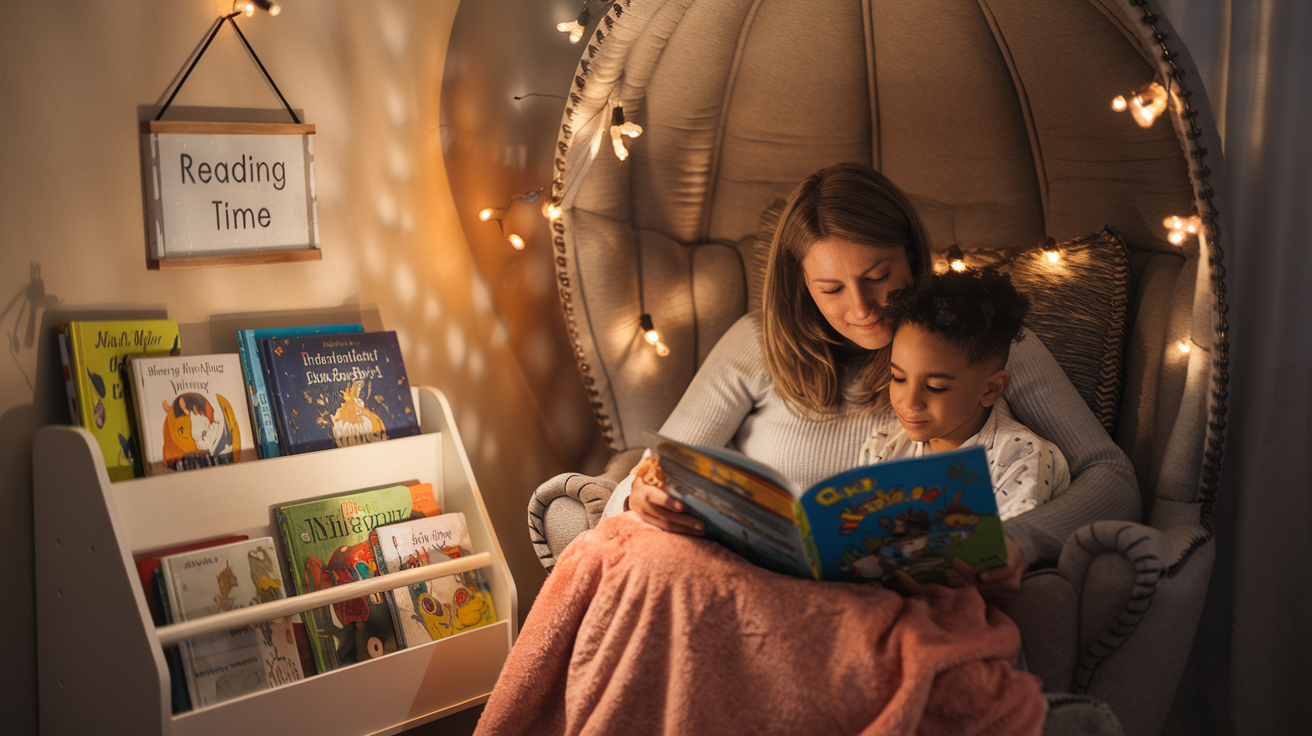
Designate Weekly Theme Nights for Different Genres
Kids thrive on anticipation and routine. Want to make reading a highlight of their week? Try setting up themed reading nights!
“Mystery Monday” might feature detective stories where you hunt for clues together. “Wilderness Wednesday” could dive into nature adventures with flashlights under a blanket fort “campsite.” “Fantasy Friday” might involve dressing up as wizards or dragons while exploring magical worlds.
The magic happens when kids start looking forward to these special nights. My friend’s daughter actually reminds her every Tuesday about “Time Travel Tuesday” because she can’t wait to jump into historical fiction or futuristic tales.
Pro tip: Let your kids help choose the themes. When they have ownership in the process, their excitement doubles!
Create Reading Passports to “Travel” Through Books
Nothing makes reading more adventurous than turning it into a global expedition! Create a simple “reading passport” with blank pages where kids can collect “stamps” for each book they complete.
Group books by countries, cultures, or even imaginary lands. After finishing a story set in Japan, stamp their passport and celebrate with a small Japanese snack or learning a Japanese word.
My nephew’s passport has over 30 “countries” visited—all through books! He proudly shows it to visitors and can tell you something about each place.
For older kids, include a small section where they write one fact they learned or draw something that represents the story.
Establish Reading Rewards That Encourage More Reading
The best reading rewards create a beautiful cycle: read more → earn reward → use reward to read even more!
Skip the candy or toy rewards. Instead, try:
- Extra reading time before bed (kids love pushing bedtime!)
- A special bookmark or book light
- A trip to the bookstore to pick a new book
- The privilege of choosing tomorrow’s bedtime story
- A “reading picnic” in a special location
One mom I know created “Book Bucks” her kids earn for completing books. They save these for a monthly book fair she sets up with used books she finds at thrift stores. The kids go wild “shopping” with their earned currency!
Remember, the goal is creating readers who love reading for its own sake, not just for external rewards.
Connect Stories to Real Life

Visit Locations Similar to Those in the Book
Books can transport kids to magical worlds, but why stop there? Take the adventure a step further by visiting real places that match the story settings. Reading about a zoo? Head to your local one! Does the story feature a castle? Find a nearby museum with medieval exhibits or even a playground with castle-themed equipment.
My friend Sarah read “Madeline” with her daughter, then planned a special day visiting landmarks in their city that reminded them of Paris. Her daughter couldn’t stop talking about how she was “just like Madeline” walking by the river.
These real-world connections help children understand that stories aren’t just words on a page – they reflect experiences they can have too.
Meet Authors at Local Bookstore Events
There’s something magical about meeting the person who created your favorite characters. Bookstores and libraries regularly host author readings where kids can ask questions and even get books signed.
My neighbor’s son was so shy until he met the author of his favorite dinosaur series. He asked three questions and talked about the experience for weeks afterward!
Most authors love sharing behind-the-scenes stories about how they created their books. Check your local bookstore’s event calendar or follow favorite authors on social media to catch upcoming appearances.
Find Real-World Examples of Story Concepts
Stories often introduce concepts that exist all around us. After reading about hibernation, go for a nature walk to spot animals preparing for winter. If a book mentions constellations, spend an evening stargazing.
When my niece read a book about recycling, we turned it into a sorting game at home with our actual recyclables. She started noticing recycling symbols everywhere we went!
Science concepts in books make particularly great real-world explorations – from watching seeds grow after reading about plants to observing weather patterns mentioned in stories.
Cook Recipes Mentioned in the Stories
Food appears in countless children’s books, from the porridge in “Goldilocks” to the blueberries in “Blueberries for Sal.” Cooking these foods brings stories to life through taste and smell.
Try making:
- Green eggs and ham (with food coloring)
- Stew from “Stone Soup” (letting kids add ingredients)
- “Very Hungry Caterpillar” fruit salad
- Cookies from “If You Give a Mouse a Cookie”
My son never liked trying new foods until we started our “storybook kitchen” nights. Now he gets excited about tasting something he “already knows” from his books!
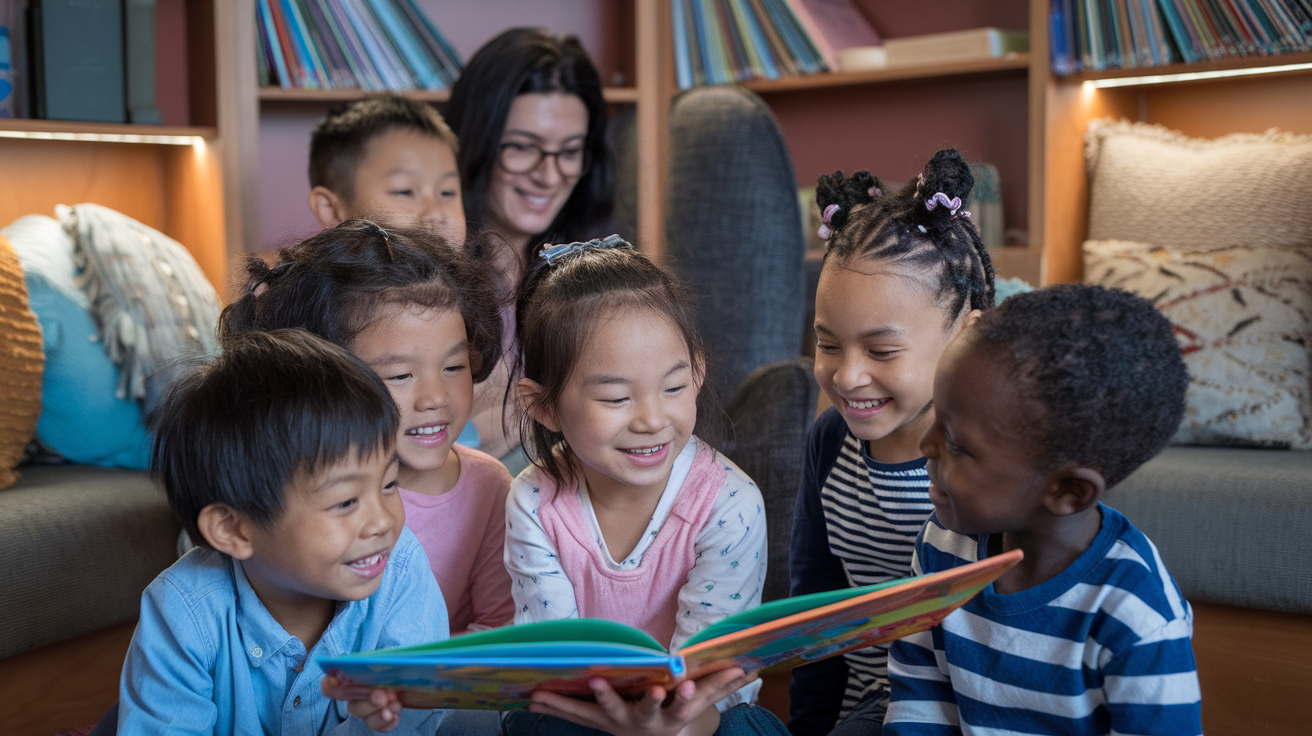
Making Storytime Magical
Transforming everyday reading sessions into captivating adventures doesn’t require elaborate preparations or expensive materials. With simple techniques like changing your voice for different characters, creating cozy reading nooks, engaging multiple senses, and making stories interactive, you can spark your child’s imagination and foster a lifelong love of reading. Whether you’re incorporating technology thoughtfully, turning reading into a game, or establishing special reading traditions, these creative approaches help children connect more deeply with stories.
Remember that the most meaningful storytime experiences come from the connection you build with your child through shared reading. By extending stories beyond books into crafts or outdoor adventures, and by helping children see connections between stories and their own lives, you’re not just teaching them to read—you’re teaching them to think, feel, and understand the world around them. Start implementing these creative strategies today, and watch as storytime becomes a cherished highlight in your child’s day.
















